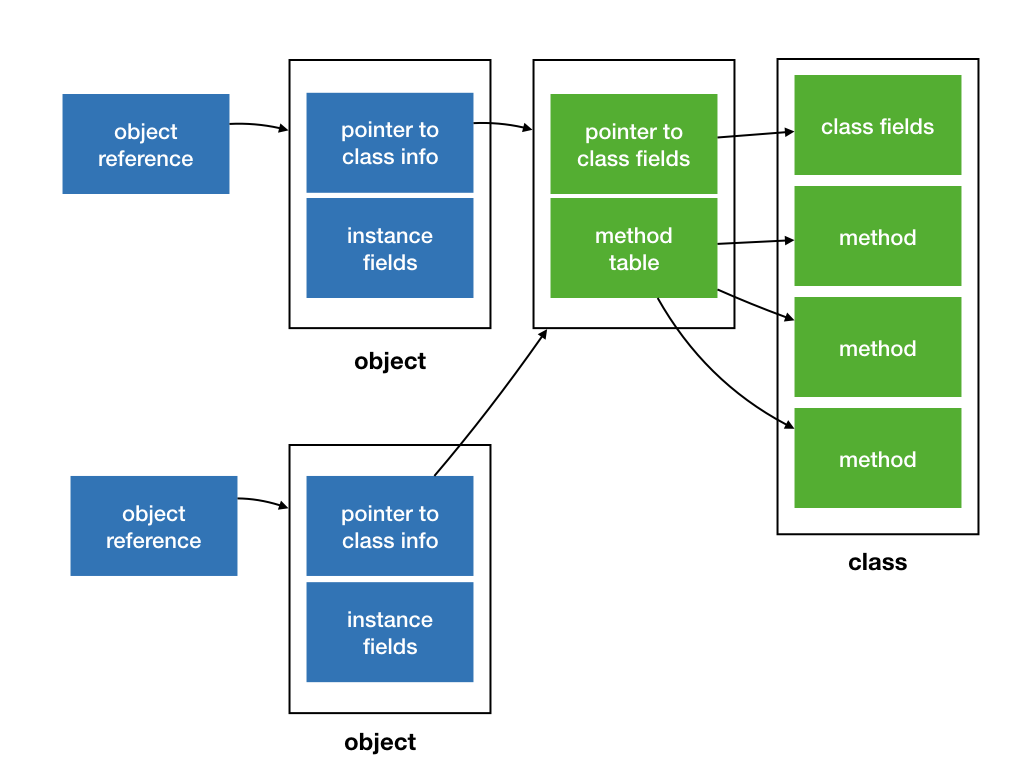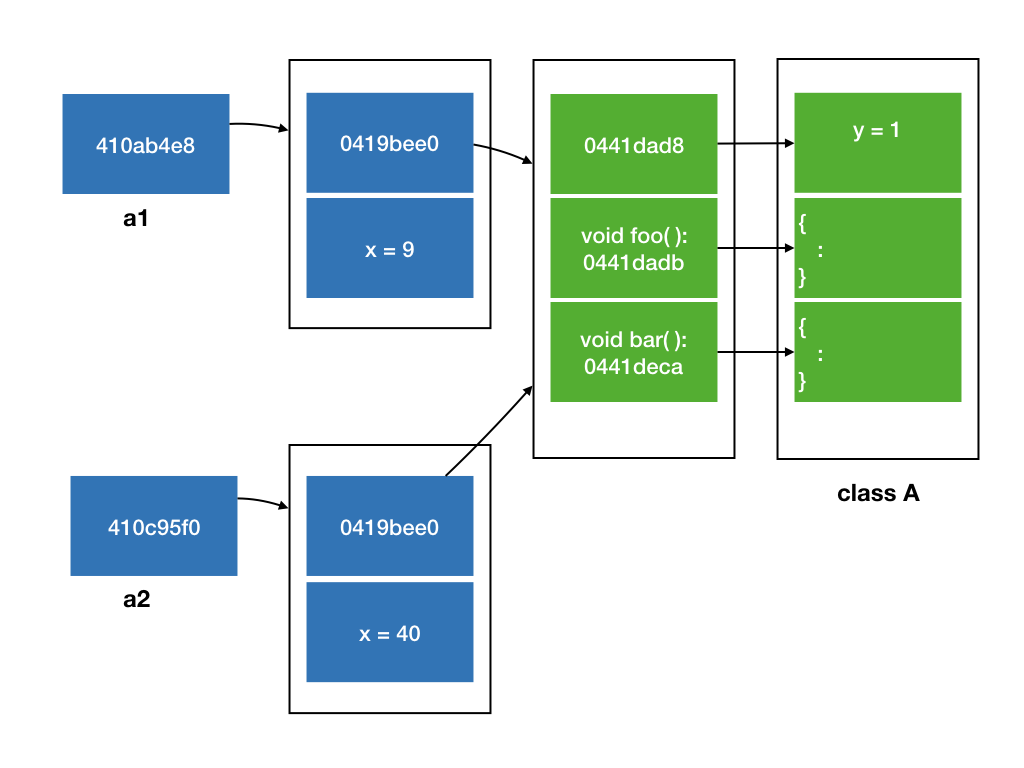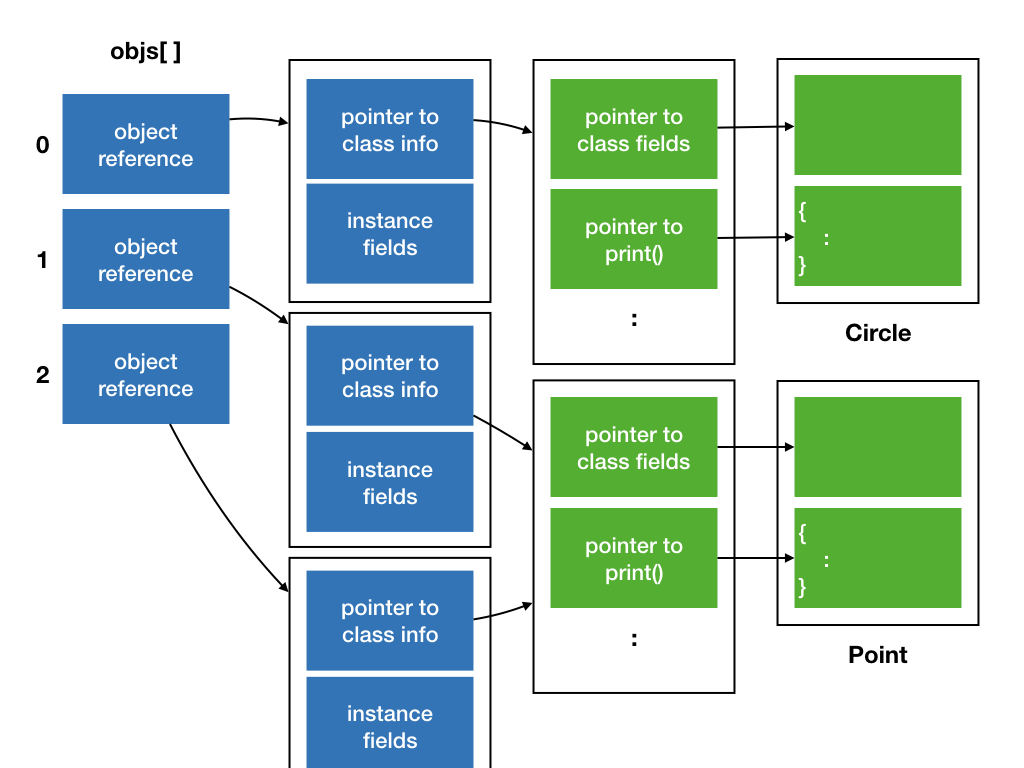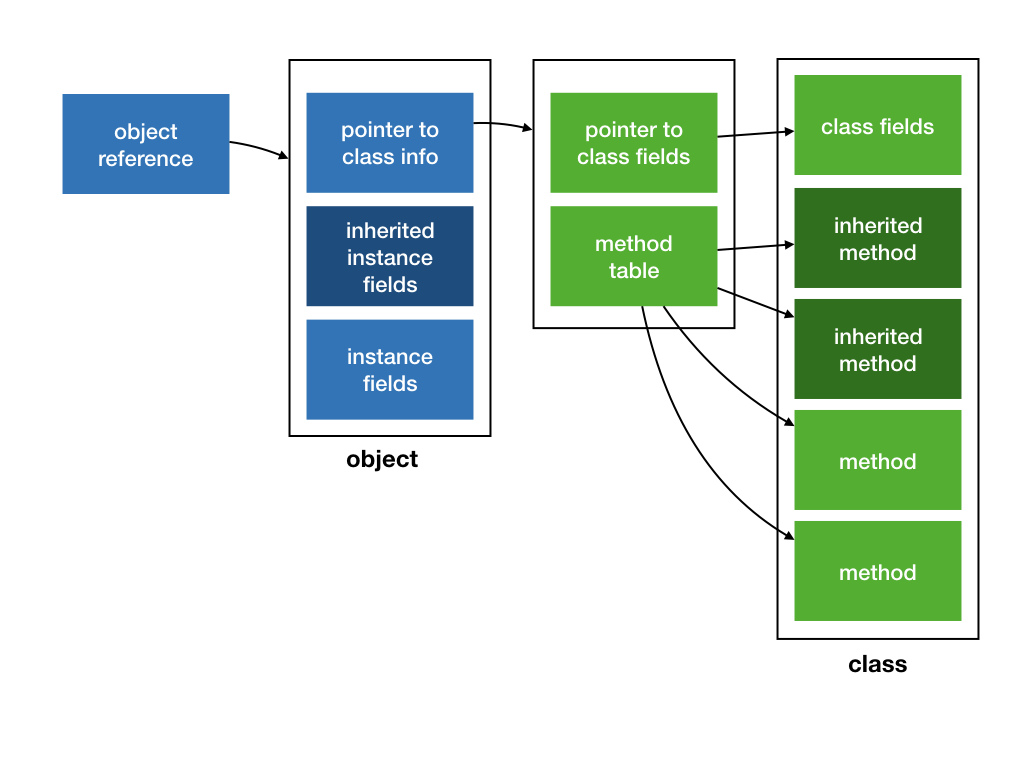Lecture 2: Inheritance & Polymorphism
Learning Objectives
After this lecture, students should:
- be able to build a mental model for how objects and classes are represented in Java
- understand the concepts of object-oriented programming, including interface, polymorphism, late binding, inheritance, method overloading, and the usage of these concepts in programming.
- know the purpose and usage of Java keywords
implements,extends,super,this, and@Override - understand Java concepts of arrays, enhanced
forloop, and method signature.
Memory Model for Objects
To help understand how classes and objects work, it is useful to visualize how they are stored in the memory. We mentioned last week that data (e.g., fields) and code (e.g., methods) are stored in two different regions in the memory. Since an object contains both fields and methods, where do we keep an object?
It turned out that different implementations of Java may store the objects differently, but here is one way that we will follow for CS2030:

In the figure above, there are two objects of the same class. An object is referred to through its reference, which is a pointer to the memory location where the instance fields for the object is stored, along with a pointer to a method table. A method table stores a table of pointers to the methods, along with a table to the class fields.
As an example, consider the following class:
1 2 3 4 5 6 7 8 9 10 11 12 13 14 | class A { private int x; static public int y; public void foo() { : } public void bar() { : } : } |
If we have two instances of A, a1 and a2, with A.y = 1, a1.x = 9, a2.x = 40, then the memory layout looks like:

Note that, we have only one copy of the static class field y, regardless of how many instances of A we create.
Enforcing Abstraction Barrier with Interface
Recall the concept of encapsulation. When we develop a large piece of software, it is important to hide the details on data representation and implementation, and only expose certain public methods for the users to use. We can imagine that there is an abstraction barrier between the code that implements the internals of a class (called the implementer) and the code that uses the class (called the client) to achieve a higher level task.
We have seen that we use private to enforce data hiding -- to hide certain fields and methods from outside of the barrier. Now, we are going to see how we can enforce that the right set of methods are defined, implemented, and used on both sides of the barrier.
The mechanism to do this is through defining an interface (aka a protocol as it is called in Objective-C or Swift). An interface is like a contract between the implementer of a class and the client of a class. If a class promises to implement an interface, then we are guaranteed that the methods defined in the interface are already implemented in the class. Otherwise, the code would not compile.
In Java, we can define an interface using interface keyword:
1 2 3 4 5 | interface Shape { public double getArea(); public double getPerimeter(); public boolean contains(Point p); } |
The example interface Shape above contains only the declaration of the methods, not the implementation.
Now, let's see how the implementer would implement a class using the interface.
1 2 3 4 5 6 7 8 9 10 11 12 13 14 15 16 17 18 19 20 21 22 23 24 25 26 27 28 29 30 | import java.lang.Math; class Circle implements Shape { private Point center; private double radius; public Circle(Point center, double radius) { this.center = center; this.radius = radius; } public void moveTo(Point p) { center = p; } @Override public double getArea() { return Math.PI * radius * radius; } @Override public boolean contains(Point p) { return (p.distance(center) < radius); } @Override public double getPerimeter() { return Math.PI * 2 * radius; } } |
This is very similar to the code you saw in Lecture 1, except that in Line 2, we say class Circle implements Shape. This line informs the compiler that the programmer intends to implement all the methods included in the interface Shape exactly as declared (in terms of names, the number of arguments, the types of arguments, returned type, and access modifier). The rest of the class is the same, except that we renamed getCircumference with getPerimeter, which is more general and applies to all shapes. We also added annotations to our code by adding the line @Override before methods in Circle that implement the methods declared in Shape. This annotation is optional, but it informs the compiler of our intention and helps make the intention of the programmer clearer to others who read the code.
Java Annotation
Annotations are metadata that is not part of the code. They do not affect execution. They are useful to compilers and other software tools, as well as humans who read the code. While we can similarly make the code more human-friendly with comments, an annotation is structured and so can be easily parsed by software. You will see 1-2 more useful annotations in this module.
this
The this keyword in Java that refers to the current object. In the example above, we use this to disambiguate the argument center and the field center. In general, it is a good practice to use this when referring the instance variable of the current object to make your intention clear.
Note that we can have other methods (such as moveTo) in the class beyond what is promised in the interface the class implements.
A class can implement more than one interface. For instance, let's say that we have another interface called Printable[^1] with a single method defined:
1 2 3 | interface Printable { public void print(); } |
The implementer of Circle wants to inform the clients that the method void print() is implemented, it can do the following:
1 2 3 4 5 6 7 8 9 10 | class Circle implements Shape, Printable { : : @Override public void print() { System.out.printf("radius: %f\n", radius); System.out.printf("center:"); center.print(); } } |
In the above, we call print() on the Point object as well. How do we know that Point provides a print() method? Well, we can read the implementation code of Point, or we can agree with the implementer of Point that Point provides a Printable interface!
It is important to note that, interface provides a syntactic contract on the abstraction barrier, but it does not provide a semantic contract. It does not, for instance, guarantee that print() actually prints something to the screen. One could still implement interface Printable as follows:
1 2 3 4 5 6 7 | class Circle implements Shape, Printable { : : @Override public void print() { } } |
and the code still compiles!
Not all programming languages that support classes support interface. C++, Javascript, and Python, for instance, do not support similar concepts.
Default Access Modifier for Interface
In the examples above, I explicitly specify the methods in the Printable and Shape interfaces as public. In Java, all methods in an interface are public by default, so the keywords public could be omitted.
Interface as Type
In Java, an interface is a type. What this means is that:
- We can declare a variable with an interface type, such as:
or1
Shape circle;
We cannot, however, instantiate an object from an interface since an interface is a "template", an "abstraction", and does not have an implementation. For instance:1
Printable circle;
1 2 3 4 | // this is not OK Printable p = new Printable(); // this is OK Printable circle = new Circle(new Point(0, 0), 10); |
-
Similarly, we can pass arguments of an interface type into a method, and the return type of a method can be an interface.
-
An object can be an instance of multiple types. Recall that Java is a statically typed language. We associate a type with a variable. We can assign a variable to an object if the object is an instance of the type of the variable. For example, Line 4 above creates a new circle, which is an instance of three types:
Circle,Shape, andPrintable. It is ok to assign this new circle to a variable of typePrintable.
We say that Shape and Printable are supertypes of Circle, and Circle is a subtype of Shape and Printable.
Late Binding and Polymorphism
We can now do something cool like this:
1 2 3 4 5 6 7 | Printable[] objs; : // initialize array objs : for (Printable o: objs) { o.print(); } |
Let's examine this code. Line 1 declares an array of objects of type Printable. We skip over the code to initialize the content of the array for now, and
jump to Line 5-7, which is a for loop. Line 5 declares a loop variable o of type Printable and loops through all objects in the array objs, and Line 6 invokes the method print of o.
Array and For Loops in Java
See Oracle's tutorial on array and enhanced loop
The magic happens in Line 6:
- First, since we know that any object in the array has the type
Printable, this means that they must implement thePrintableinterface and support the methodprint(). - Second, we do not know, and we do not need to know which class an object is an instance of.
- Third, we can actually have objects of completely unrelated classes in the same array. We can have objects of type
Circle, and objects of typePoint. We can have objects of typeFactory, or objects of typeStudent, or objects of typeCushion. As long as the objects implement thePrintableinterface, we can put them into the same array. - Fourth, at run time, Java looks at the object
o, and determines its class, and invokes the right implementation ofprint()corresponding to theo. That is, ifois an instance of a classCircle, then it will callprint()method ofCircle; ifois an instance of a classPoint, then it will callprint()method ofPoint, and so on.
To further appreciate the magic in Line 6, especially on last point above, consider how a function call is done in C. In C, you cannot have two functions of the same name within the same scope, so if you call a function print(), you know exactly which set of instructions will be called1. So, the name print is bound to the corresponding set of instructions at compilation time. This is called static binding or early binding.
To have print() for different types, we need to name them differently to avoid naming conflicts: e.g., print_point(), print_circle().
In a language with static binding, suppose you want to mix objects of different types together in an array, you need to do something like the following pseudocode:
1 2 3 4 5 6 7 8 9 | for each object in the array if object is a point print_point(object) else if object is a circle print_circle(object) else if object is a square print_square(object) : : |
Not only is the code verbose and ugly, it would be cumbersome if you define a new compound data type that supports printing, since you would need to remember to add a new if-else condition to call for a corresponding print function.
In OO languages, you can have methods named print() implemented differently in different classes. When we compile the code above, the compiler will have no way to know which implementation will be called. The bindings of print() to the actual set of instructions will only be done at run time, after the object o is instantiated from a class. This is known as dynamic binding, or late binding, or dynamic dispatch.

If you understand how an object is represented internally, this is not so magical after all. Referring to the figure above, the array objs[] contains an array of references to objects, the first one is a Circle object, and the following two are Point objects. When o.print() is invoked, Java refers to the method table, which points to either the method table for Circle or for Point, based on the class the object is an instance of.
This behavior, which is common to OO programming languages, is known as polymorphism2.
The Abstraction Principle
With the interface Shape, we can implement other classes, such as Rectangle, Square, Polygon with the same interface. For instance,
1 2 3 | class Rectangle implements Shape, Printable { // left as exercise (See Exercise 2) } |
So far, we have been treating our shapes as pure geometric objects. Let's consider an application where we want to paint the shapes. Each shape should have a fill color and a border (with color and thickness).
1 2 3 4 5 6 7 8 9 10 11 12 13 14 15 16 17 18 19 20 21 22 23 | import java.awt.Color; : class PaintedCircle implements Shape, Printable { private Color fillColor; private Color borderColor; private double borderThickness; public void fillWith(Color c) { fillColor = c; } public void setBorderThickness(double t) { borderThickness = t; } public void setBorderColor(Color c) { borderColor = c; } // other methods and fields for Circle from before } |
In the code above, we added the line import java.awt.Color to use the Color class that Java provides, and added three private members as well as their setters.
We can do the same for Triangle
1 2 3 4 5 6 7 8 9 10 11 12 13 14 15 16 17 18 19 20 21 22 23 | import java.awt.Color; : class PaintedTriangle implements Shape, Printable { private Color fillColor; private Color borderColor; private double borderThickness; public void fillWith(Color c) { fillColor = c; } public void setBorderThickness(double t) { borderThickness = t; } public void setBorderColor(Color c) { borderColor = c; } // other methods and fields written for Triangle } |
and for other shapes.
Great! We now have colorful shapes. The code above, however, is not good code, even though it is correct. Just consider what needs to be done if we decide to support border styles (dotted border, solid border, dashed border, etc). We would have to edit every single class that supports colors and borders!
One principle that we can follow is the abstraction principle, which says "Each significant piece of functionality in a program should be implemented in just one place in the source code. Where similar functions are carried out by distinct pieces of code, it is generally beneficial to combine them into one by abstracting out the varying parts."3
Following the principle, we want to implement these style-related fields and methods in just one place. But where?
Inheritance
The OO-way to do this is to create a parent class, and put all common fields and methods into the parent. A parent class is defined just like a normal class. For instance:
1 2 3 4 5 6 7 8 9 10 11 12 13 14 15 16 17 18 19 20 21 22 23 | class PaintedShape { private Color fillColor; private Color borderColor; private double borderThickness; public PaintedShape(Color fillColor, Color borderColor, double borderThickness) { this.fillColor = fillColor; this.borderColor = borderColor; this.borderThickness = borderThickness; } public void fillWith(Color c) { fillColor = c; } public void setBorderThickness(double t) { borderThickness = t; } public void setBorderColor(Color c) { borderColor = c; } } |
The PaintedCircle class, PaintedSquare class, etc, can now inherits non-private fields and methods from the parent class, using the extends keyword.
1 2 3 4 5 6 7 | class PaintedCircle extends PaintedShape implements Shape, Printable { : } class PaintedSquare extends PaintedShape implements Shape, Printable { : } |
This mechanism for a class to inherit the properties and behavior from a parent is called inheritance, and is the fourth and final basic OO principles we cover4.
With inheritance, we do not have to repeat the declaration of fields fillColor, borderColor, borderThickness and the associated methods in them. This software engineering principle is also known as the DRY principle -- "don't repeat yourself" principle. We are going to see DRY very regularly in future lectures.
We also call the PaintedShape the superclass (or base class) of PaintedCircle and PaintedSquare, and call PaintedCircle and PaintedSquare the subclass (or derived class)5 of PaintedShape.
A PaintedCircle object can now call fillWith() even if the method fillWith() is not defined in PaintedCircle -- it is defined in PaintedCircle's parent PaintedShape.
When a class extends a parent class, it inherits all the non-private fields and methods, so we can depict the objects and the class as follows:

The method table now includes pointers to methods defined in the parent (and grandparents, and so on).
Overloading
Now consider the constructor for PaintedCircle. We need to initialize the geometric shape as well as the painting style. But, we define the fields fillColor, etc private, and thus subclasses have no access to private fields in the parent. We need to call the constructor of the parent to initialize these private fields. The way to do this is to use the super keyword, as such:
1 2 3 4 5 | public PaintedCircle(Point center, double radius, Color fillColor, Color borderColor, double borderThickness) { super(fillColor, borderColor, borderThickness); this.center = center; this.radius = radius; } |
You can see that the constructor for PaintedCircle now takes in five parameters. You can imagine that as the class gets more sophisticated with more fields, we need to pass in more parameters to the class to initialize the fields. It is not uncommon to provide alternative constructors with fewer parameters and assign some default values to the fields.
1 2 3 4 5 6 7 8 9 10 11 12 13 | // create circle with default style (white with black border of thickness 1) public PaintedCircle(Point center, double radius) { super(Color.WHITE, Color.BLACK, 1.0); this.center = center; this.radius = radius; } // create circle with customized styles public PaintedCircle(Point center, double radius, Color fillColor, Color borderColor, double borderThickness) { super(fillColor, borderColor, borderThickness); this.center = center; this.radius = radius; } |
Two methods in a class can have the same name and still co-exist peacefully together. This is called overloading. When a method is called, we look at the signature of the method, which consists of (i) the name of the method, (ii) the number, order, and type of the arguments, to determine which method is called. To be precise, the first sentence of this paragraph should read: Two methods in a class can have the same name and still co-exist peacefully together, as long as they have different signatures. Note that the return type is not part of the method signature, so you cannot have two methods with the same name and same arguments but different return type.
Even though the example above shows overloading of the constructor, we can overload other methods as well.
Exercise
-
Consider what happen when we do the following:
1 2 3
Circle c = new Circle(new Point(0,0), 10); Shape c1 = c; Printable c2 = c;
Are the following statements allowed? Why do you think Java does not allow some of the following statements?
1 2 3 4
c1.print(); c2.print(); c1.getArea(); c2.getArea();
-
Write another class
Rectanglethat implements these two interfaces. You should make use of the classPointthat you implemented from Lecture 1's exercise. Then write another classPaintedRectanglethat implements the two interfaces and inherits fromPaintedShapethat implements the two interfaces and inherits fromPaintedShape. You can assume that the sides of the rectangles are parallel with the x- and y-axes (in other words, the sides are either horizontal or vertical). -
(i) Write an interface called
Shape3Dthat supports a methodgetVolume. Write a class calledCuboidthat implementsShape3Dand has three privatedoublefieldslength,height, andbreadth.getVolume()should return the volume of theCuboidobject. The constructor forCuboidshould allow the client to create aCuboidobject by specifying the three fieldslength,heightandbreadth.(ii) We can extend one interface from another as well. Find out how, and write a new interface
Solid3Dthat inherits from interfaceShape3Dthat supports a methodgetDensityandgetMass.(iii) Now, write a new class called
SolidCuboidwith an additional privatedoublefielddensity. The implementation ofgetDensity()should return this field whilegetMass()should return the mass of the cuboid. TheSolidCuboidshould call the constructor ofCuboidviasuperand provides two constructors: one constructor allows the client to specify the density, and the other does not and just set the default density to 1.0. -
Write a class
Rectanglethat implementsShape. ARectangleclass has twodoublefields,lengthandwidth, and a public methodsetSize(int length, int width)that allows the client to change its size.Now, write a class
Squarethat inherits fromRectangle. ASquarehas an additional constraint thatlengthmust be the same aswidth. How shouldSquareimplement thesetSize(int length, int width)method? Do you thinkSquareshould inherit fromRectangle? Or should it be another way around? Or maybe they should not inherit from each other?(Note: to implement the
containsmethod inShape, you need to also keep the position of theSquare(top left corner, for instance). But, it is not important for this question)
-
Remember a function is just an abstraction over a set of instructions. ↩
-
In biology, polymorphism means that an organism can have many different forms. ↩
-
This principle is formulated by Benjamin C. Pierce in his book Types and Programming Languages. ↩
-
The other three is encapsulation, abstraction, and polymorphism. ↩
-
Again, you see that computer scientist can be quite indecisive when it comes to the terminologies in OOP. ↩